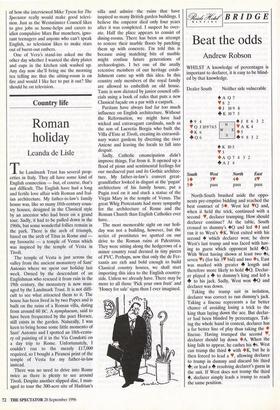Country life
Roman holiday
Leanda de Lisle
The temple of Vesta is just across the valley from the ancient monastery of Sant' Antonio where we spent our holiday last week. Owned by the descendant of an Englishman who rescued it from ruin in the 19th century, the monastery is now man- aged by the Landmark Trust. It is not diffi- cult to see what attracted them to it. The house has been lived in by two Popes and is built on the ruins of a Roman villa, dating from around 60 BC. A nymphaeum, said to have been frequented by the poet Horace, still exists in the garden. Naturally, I was keen to bring home some little momento of Sant' Antonio and I spotted an 18th-centu- ry oil painting of it in the Via Condotti on a day trip to Rome. Unfortunately, I couldn't run to the measly £17,000 required, so I bought a Piranesi print of the temple of Vesta for my father-in-law instead.
There was no need to drive into Rome twice as there is plenty to see around Tivoli. Despite another slipped disc, I man- aged to tour the 300-acre site of Hadrian's villa and admire the ruins that have inspired so many British garden buildings. I believe the emperor died only four years after it was completed. I suspect he over- ate. Half the place appears to consist of dining-rooms. There has been an attempt to restore their marble floors by patching them up with concrete. I'm told this is because using matching bits of marble might confuse future generations of archaeologists. I bet one of the anally retentive members of our heritage estab- lishment came up with this idea. In this country only members of the royal family are allowed to embellish an old house. Taste is now dictated by junior council offi- cials using a book of rules that puts a new Classical façade on a par with a carpark.
Puritans have always had far too much influence on English architecture. Without the Reformation, we might have had wicked and extravagant cardinals, such as the son of Lucretia Borgia who built the Villa d'Este at Tivoli, creating its extraordi- nary water gardens by diverting the river Aniene and leaving the locals to fall into despair.
Sadly, Catholic emancipation didn't improve things. Far from it. It opened up a flood of pious and sentimental feelings for our mediaeval past and its Gothic architec- ture. My father-in-law's convert great- grandfather looked in disgust at the 'pagan' architecture of his family house, put a Pugin roof on it and stuck a statue of the Virgin Mary in the temple of Venus. The great Whig Protestants had more sympathy for the architecture of Rome and the Roman Church than English Catholics ever have.
The most memorable sight on our holi- day was not a building, however, but the series of prostitutes we spotted on our drive to the Roman ruins at Palestrina. They were sitting along the hedgerows of a minor country road dressed in tiny pieces of PVC. Perhaps, now that only the de Fer- rantis are rich and bold enough to build Classical country houses, we shall start importing this idea to the English country- side. Unless we already have. There may be more to all those 'Pick your own fruit' and `Honey for sale' signs than I ever imagined.


















































































 Previous page
Previous page